Branch and Directorate
Communications and Marketing Branch
Rationale
Industry Canada commissioned TNS Canadian Facts to conduct a survey among the general public to explore corporate and economic issues of relevance to the Department.
Background and Objectives
In 2002–2003, Industry Canada undertook a baseline survey of business and the general public to explore a range of issues of interest to the Department. In 2004–2005, a follow-up survey was conducted. The current research builds on the two earlier waves of research and track attitudinal changes over time, while exploring new issues. The overall purpose of this research is to survey the Canadian public's views regarding Industry Canada priorities and performance—especially as related to government efforts to promote innovation and research and development in Canada and among Canadian businesses.
Anticipated Outcomes and Benefits
The information gathered will help:
- Enrich Industry Canada's research program with custom research that explores departmental priorities, performance, policies and communications.
- Allow for greater dissemination of research findings within the Department and outside of the Department to Portfolio members and to the general public.
- Track findings from the 2002–2003 and the 2004–2005 studies.
- Help inform communications initiatives and policy direction.
Research Information
A total of 1200 telephone interviews were conducted between February 5 and March 1, 2007, with a random sample of members of the general public, aged 18 years and older. Based on a sample of this size, results can be considered accurate to within +/-2.9%.
Research firm: TNS Canadian Facts
Contract number: U1400-062276-001-CY
Contract issued by: Public Works and Government Services Canada
Contract value: $62 439.83, including GST
Industry Canada 2007: General Population Survey Final Report
Industry Canada 2007: General Population Survey Final Report
POR number 341-06
March 2007
Prepared for:
Industry Canada
Communications and Marketing Branch
C.D. Howe Building
Room 442D, 235 Queen Street
Ottawa, Ontario K1A 0H5
Canada
Telephone: 343-291-3578
Fax: 613-952-5162
Email: janis.camelon@canada.ca
Contract Award Date: January 19, 2007
Contract Number: U1400-062276-001-CY
Prepared by: TNS Canadian Facts
Order of Contents
- Executive Summary
- Detailed Analysis
- Background and Objectives
- Industry Canada Priorities and Performance
- Role of Government in the Economy
- Research and Development
- Science and Technology
- Telecommunications
- Satisfaction with Current Telecommunications Services in Canada
- Preference Between Detailed and General Telecommunications Rules
- Preference Between Government Approval or not for New Telecommunications Services
- Preference Between Encouraging Foreign Investment in Canada's Telecommunications Sector or Maintaining Current Limits
- Methodology
- Field Materials
I. Executive Summary
Methodology
Industry Canada commissioned TNS Canadian Facts to undertake a national survey to explore a range of issues of interest to the department. A total of 1,200 telephone interviews were conducted between February 5 and March 1, 2007 with a random sample of members of the general public, aged 18 years and older. Based on a sample of this size, results can be considered accurate to within +/-2.9%.
Industry Canada Priorities and Performance
Although certain activities are seen as more pressing than others, a majority of Canadians assign importance to a range of potential priorities that the Government of Canada could pursue to encourage economic growth. In fact, since 2005 there have been substantial increases in importance for several priority areas tested and only one attribute (encouraging innovation and research and development) for which slightly fewer Canadians award importance (a drop of 2 points since 2005).
In terms of specific priorities on which Industry Canada can focus to support business and encourage economic growth, promoting sustainable development emerges as number one. Since the beginning of the Industry Canada tracking study in 2003, sustainable development has consistently been rated by the public as an important priority on which Industry Canada can focus to support business and encourage economic growth. This latest wave of research reveals that the importance awarded to sustainable development is on the rise, from 82% in 2005 to 90% in 2007.
Other priorities identified as key in previous iterations of research, continue to be important. These include encouraging regional economic development (87%, up significantly from 75% in 2005), encouraging more investment in the economy and Canadian businesses (85%, up from 82% in 2005) and ensuring a fair marketplace for consumers (83%, up from 76% in 2005). Inter-provincial trade, which had not been measured in previous waves of research, emerges as a top-ranked issue at 80%.
A number of issues are ranked as mid-range priorities. These are the attributes that have seen the fewest shifts in importance since 2005. Encouraging innovation and research and development (R&D) among Canadian businesses is the only issue that has dropped in importance (78%, down from 80% in 2005). Other attributes considered to be moderately important include investing in growing sectors of the economy (77%, up from 70% in 2005) and supporting the commercialization or market success of products and services that are researched or developed in Canada (75%, up from 73% in 2005).
Although still supported by a majority, fewer Canadians feel a high priority should be placed on making government services for business readily accessible on the Internet (70%, up from 60 in 2005), helping businesses in declining economic sectors adjust to the new economy (70%, up from 54%) and ensuring all Canadian communities have access to high-speed Internet (68%, up from 45%). Interestingly, although they are relegated to the bottom of the list of priorities, the increase in importance awarded to each of these three issues is significantly higher in 2007 than in 2005 and surpass increases seen in most, if not all, of the other measures tested.
On the question of performance on these same issues, with the exception of two attributes, fewer than half of Canadians award positive scores. That said, the performance scores have increased for every single measure since 2005 and many of these increases are large (more than 10 points).
Making government services for business readily accessible on the Internet (56% up from 46% in 2005) and investing in growing sectors of the economy (53% up from 40% in 2005), two areas perceived to be relatively low in importance (70% and 77% respectively), are the only two areas tested, where the Government of Canada's performance is perceived to be positive by a majority of Canadians.
Performance scores for remaining areas tested range from 49% for encouraging more investment in the economy to a low of 36% for helping businesses that are in declining economic sectors adjust to the new economy. Within this range, the areas where performance improved the most from 2005 are: encouraging regional economic development (45% from 33% in 2005) and ensuring all communities have high-speed access to the Internet (42% from 31% in 2005).
There are significant gaps between the priority and the performance scores Canadians attribute to a particular issue. At 52 points (an increase in 10 points since 2005), the most pronounced priority/performance gap is for promoting sustainable development, followed by encouraging regional economic development (41-point gap). The priority area with the smallest gaps remain the same as in 2005: ensuring all communities have high-speed access (14 points) and making government services for business readily accessible on the Internet (15 points).
Role of Government and Business Assistance
Overall, Canadians perceive that the Government of Canada is currently playing a minimal role in the economy, despite this being their least preferred role.
When it comes to the economy, one third of Canadians (31%) think that the Government of Canada currently plays a small and limited role, while a smaller proportion (9%) think the government is very involved in a leadership role. It is, however, a leadership role (25%) or at least a partnership role (35%) that Canadians would prefer. Fewer than one in ten (9%) believe that the Government of Canada is taking an active leadership role in the economy whereas 25% would prefer that it assume this role.
The desire for more government involvement is in keeping with the desire to have government provide business assistance. As in past iterations of the study, the notion of repayment does not increase support for assistance.1 Interestingly, there is almost equal support for the government providing assistance to businesses with a proven track record (86%), where there is presumably less risk, as there is for businesses which have trouble accessing capital (83%), where risk would likely be higher. One in five Canadians (20%) is of the view that government assistance to business is always wrong.
Canadians place importance on several measures the Government of Canada can put in place to ensure responsible investment when it does play a leadership role in the economy by investing public funds. Measures consistently deemed to be important include those assuring accountability (ensuring clear reporting of investments and anticipated results, 91%) and those involving political considerations (safeguards against political influence, 90%; and regional equality, 86%). Although still considered to be important by a strong majority, slightly fewer award importance to basing investment decisions on recommendations from independent experts (80%), ensuring investments are repayable (78%) and ensuring other groups like local government and businesses support the initiative by cost sharing (78%).
Perhaps not surprising given the priority attributed to sustainable development, the environmental technologies industry (95%) and natural resources sector (95%) are perceived as the most valuable for the future health of the Canadian economy. In comparison, fewer think that automotive (67%) or aerospace sectors (69%) are important.
1 Half the sample was asked the question with the word repayable and the other half was asked the question without signaling out that the assistance is repayable.
Research and Development (R&D)
In line with previous waves of research, while Canadians think that R&D is important, they have difficulty naming specific economic benefits by which R&D is turned into economic advantage for Canada. Some specific benefits listed include improved standard of living (12%) and increased competitiveness (11%), but an overwhelming 43% are unable to name a single benefit to Canada of having the federal government support R&D activities.
Canadians overwhelmingly feel that both R&D (97%) and innovation (98%) are important to sustained economic growth and a higher quality of life (94% and 92% respectively).
The link Canadians make between the economy and R&D or innovation is evident across a range of attributes:
- 89% agree it is important that Canada be more technologically advanced than other countries, with fully half (50%) indicating they strongly agree with the statement.
- Although down from highs of 81% in 2005 and 2003, fully 74% are concerned with Canada's ability to be a leader in the knowledge-based economy.
- 97% think it is important that Canadian businesses are innovative, and continue to develop new products, services and ideas.
- 92% think that Canadians businesses need to do a better job of using and marketing R&D output, and fully half (52%) hold strong views on this issue.
Science and Technology (S&T)
When it comes to the promotion of science and technology, public support is almost equally strong for both encouraging businesses to work with post-secondary institutions (93%) and direct support of the development of these skills within the educational sector (91%).
Telecommunications
The public is generally satisfied with telecommunications services in Canada and in particular with the level of innovation (80%), the strength of Canadian-owned telecommunications companies (77%) and the ability of Canada's telecommunications system to help keep our economy competitive (77%). The Canadian public is less satisfied with Canadian-based telecommunications R&D (69%), and access to telecommunications services in rural areas (58%).
While overall many express a desire for the government to take a leadership role in the economy, the public strongly favours having government take an arms length approach with respect to telecommunications rules (62%) and the introduction of new services (58%).
Perhaps because of their satisfaction with the current services, the public is against changing the rules with respect to the introduction of foreign competition in the telecommunications sector, even if it were to yield more innovation and new technologies. In this case, the desire for government to maintain the current course is evident.
II. Detailed Analysis
1. Background and Objectives
The overall purpose of this research is to survey the Canadian public's views regarding Industry Canada priorities and performance — especially as related to government efforts to promote innovation and research and development in Canada and among Canadian businesses.
The general public survey has four key objectives:
- To enrich Industry Canada's research program with custom research that allows for exploration of departmental priorities, performance, policies and communications.
- To allow for greater dissemination of public opinion research (POR) findings within the department and outside of the department to portfolio members and to the general public.
- To track findings from the 2002/2003 and 2004/2005 benchmark general public and the January 2007 business studies.
- To help inform communications initiatives and policy direction.
2. Industry Canada Priorities and Performance
2a. Priorities to Encourage Economic Growth
Although the support varies depending on the issue at hand, Canadians generally support the priorities that the Government of Canada could pursue to encourage economic growth in Canada. In fact, these economic issues continue to resonate with the public and are gaining importance. Since 2005 there have been substantial increases in importance for several priority areas tested and only one attribute (encouraging innovation and R&D) for which slightly fewer Canadians award importance (a drop of 2 points since 2005).
Promoting sustainable development, which tied as one of the top two issues in 2005, emerges as the most important priority for Canadians in 2007. Nine out of ten (90%) give it a high priority rating. At 60%, it is also worth noting that this is the issue for which the greatest proportion of Canadians award the highest importance score (7 on a 7-point scale). No other issue comes close to this level of priority, which may be explained by the combination of events that drew considerable attention to the environment as an issue in the early months of 2007.2
Among the other top priorities is encouraging regional economic development, which has significantly risen in importance (87%, up from 75% in 2005 and 81% in 2003). The third and fourth priorities are encouraging more investment in the economy (85%, up from 82% in 2005) and ensuring a fair market place for consumers (83%, up from 76% in 2005). Inter-provincial trade, which had not been measured in previous waves of research, emerges as a top-ranked issue at 80%.
A number of issues are ranked as mid-range priorities. These are the attributes that have seen the fewest shifts in importance since 2005. Encouraging innovation and research and development among Canadian businesses is the only issue that has dropped in importance (78%, down from 80% in 2005). The decrease is negligible given that it is within the margin of error. Other attributes considered to be moderately important include investing in growing sectors of the economy (77%, up from 70% in 2005) and supporting the commercialization or market success of products and services that are researched or developed in Canada (75%, up from 73% in 2005). Again, this change from 2005 is within the margin of error.
2 In addition to international developments such as the report titled Climate Change 2007: The Physical Science Basis (Intergovernmental Panel on Climate Change) that was released on February 2, the Government of Canada made a number of environment-related announcements in January and February of 2007.
Although still supported by a majority, fewer Canadians feel a high priority should be placed on making government services for business readily accessible on the Internet (70%, up from 60 in 2005), helping businesses in declining economic sectors adjust to the new economy (70%, up from 54%) and ensuring all Canadian communities have access to high-speed Internet (68%, up from 45%). Interestingly, although they are relegated to the bottom of the list of priorities, the increase in importance awarded to each of these three issues is significantly higher in 2007 than in 2005 and surpasses increases seen in most, if not all, of the other measures tested.
Figure 2-a
Perceived Importance of Priority Areas
Q: The Government of Canada has identified a number of potential priorities it can pursue to support businesses and to encourage economic growth in Canada. For each of the following, please tell me how much emphasis you think should be placed on that particular area.
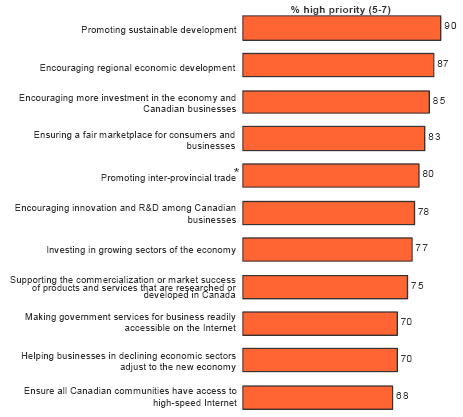
*Note: 'Promoting inter-provincial trade' was added in 2007
Don't know/ Not stated removed
Base: 2005 (N=600/601) ; 2007 Bases vary by statement
2007 TNS Canadian Facts
| *Note: Bases very by statement. | ||||
| Year | Change from 2005 | |||
| 2003 | 2005 | 2007 | ||
| Base = actual | (600/601) % | (600/601) % | (600) % | |
| Promoting sustainable development — that is economic growth that does not harm the environment | 86 | 82 | 90 | 8 |
| Encouraging regional economic development | 81 | 75 | 87 | 12 |
| Encouraging more investment in the economy and Canadian businesses | 87 | 82 | 85 | 3 |
| Ensuring a fair marketplace for consumers and businesses | 82 | 76 | 83 | 7 |
| Promoting inter-provincial trade | - | - | 80 | |
| Encouraging innovation and R&D among Canadian businesses | - | 80 | 78 | -2 |
| Invest in growing sectors of the economy | 72 | 70 | 77 | 7 |
| Supporting the commercialization or market success of products and services that are researched or developed in Canada | - | 73 | 75 | 2 |
| Making government services for business readily accessible on the Internet | 63 | 60 | 70 | 10 |
| Help businesses that are in declining economic sectors adjust to the new economy | 58 | 54 | 70 | 6 |
| Ensuring that all Canadian communities have high-speed access to the Internet | 44 | 45 | 68 | 23 |
Regional differences
- Encouraging regional economic development is more likely to be a high priority in Atlantic Canada (97%) than in the other provinces (Quebec, 87%; Ontario, 89%; Prairies, 86%; B.C., 78%).
- Regionally, Atlantic (87%) and B.C. (87%) residents are more likely to feel that inter-provincial trade is important compared to those in Ontario (77%), Quebec (83%) and the Prairies (75%).
- Quebec residents (56%) are far less likely to feel that ensuring all Canadian communities have access to high-speed Internet should be a priority (Atlantic, 82%; Ontario, 70%; Prairies, 76%; B.C., 70%).
2b. Perceived Performance of the Government of Canada
In each priority area, fewer than half of Canadians award positive scores to the Government's performance. That said, the performance scores have increased for every single measure since 2005 and many of these increases are large (more than 10 points).
Making government services for business readily accessible on the Internet (56% up from 46% in 2005) and investing in growing sectors of the economy (53% up from 40% in 2005), two areas perceived to be relatively low in importance (70% and 77% respectively), are the only two areas tested, where the Government of Canada's performance is perceived to be positive by a majority of Canadians.
For encouraging regional development and encouraging more investment in the economy, nearly half of Canadians feel that the Government is doing a good job (45% and 49%, respectively). Encouraging regional economic development is also one of the areas that saw performance rise by a large margin from 2005 to 2007 (45% from 33% in 2005).
In terms of promoting inter-provincial trade, a newly-added attribute in 2007, performance is slightly better than average, with just under half (46%) of Canadians stating that the Government is doing a good job.
The two areas where the negative outweigh the positive are with respect to helping businesses that are in declining economic sectors adjust to the new economy (36% positive and 41% negative) and for promoting sustainable development (38% positive and 43% negative). Although performance on promoting sustainable development did not improve significantly since 2005, there were considerable gains in the proportion who think performance improved on helping declining sectors (from 28% to 36% since 2005).
Figure 2-b
Performance in Priority Areas
Q: How would you rate the performance of the Government of Canada in each of these same areas?
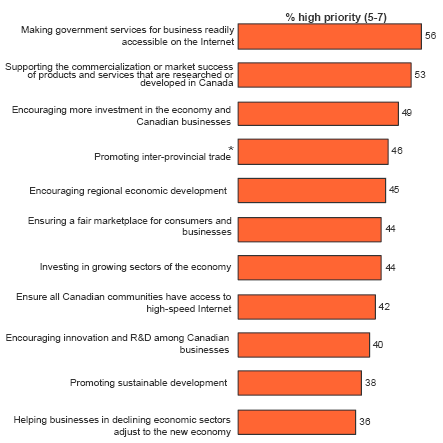
*Note: 'Promoting inter-provincial trade' was added in 2007
Don't know/ Not stated removed
Base: 2005 (N=600/601) ; 2007 Bases vary by statement
2007 TNS Canadian Facts
Regional differences
- When it comes to sustainable development, an area of highest perceived priority, performance is relatively poor and B.C. residents are the most critical (25% are positive). In comparison, positive assessments are almost twice as likely elsewhere in Canada (43% of Atlantic; 42% of Quebec; 38%, of Ontario, and 40% in the Prairies).
- Ontario residents are the most likely to think that performance is poor (31% are positive) for helping businesses in declining economic sectors adjust to the new economy. In comparison, 42% of those in Atlantic Canada; 41% of Quebec; 40% of Prairies, and 34% in B.C.) rate the Government's performance positively on this measure.
- Regional differences are evident when it comes to assessing performance on regional economic development efforts. Prairies residents (60%) are the most positive about regional economic development efforts, while Ontario (41%) and B.C. (39%) residents are the most negative.
- Regionally, Atlantic (57%) and Quebec (61%) residents feel that the Government is doing a better job of investing in growing sectors of the economy than their counterparts in Ontario (51%) and western Canada (Prairies, 43%; B.C., 50%).
- Similarly, Ontario (46%) and B.C. (40%) residents feel that the Government is doing a poor job of encouraging more investment in the economy. In comparison, more than half of the residents of the other provinces rate the performance positively (Quebec, 53%; Prairies, 54%; Atlantic, 52%).
| *Note: Bases very by statement. | ||||
| Year | Change from 2005 | |||
| 2003 | 2005 | 2007 | ||
| Base = actual | (600/601) % | (600/601) % | (600) * | |
| Making government services for business readily accessible on the Internet | 48 | 46 | 56 | 10 |
| Invest in growing sectors of the economy | 42 | 40 | 53 | 13 |
| Encouraging more investment in the economy and Canadian businesses | 48 | 42 | 49 | 7 |
| Promoting inter-provincial trade | New | New | 46 | |
| Encouraging regional economic development | 40 | 33 | 45 | 12 |
| Ensuring a fair marketplace for consumers and businesses | 39 | 37 | 44 | 7 |
| Supporting the commercialization or market success of products and services that are researched or developed in Canada | New | 37 | 44 | 7 |
| Ensuring that all Canadian communities have high-speed access to the Internet | 30 | 31 | 42 | 11 |
| Encouraging innovation and research and development among Canadian businesses | New | 35 | 40 | 5 |
| Help businesses that are in declining economic sectors adjust to the new economy | 27 | 28 | 36 | 8 |
| Promoting sustainable development — that is economic growth that does not harm the environment | 42 | 37 | 38 | 1 |
2c. Priority versus Performance
As the discussion about performance indicates, there is a gap between the priority that Canadians assign to some issues and the performance score they attribute to the item.
Since 2005, gaps have widened for:
- Promoting sustainable development: 52-point gap, up from 4 points in 2005. Note the gap has widened because of the priority increase.
- Helping businesses that are in declining sectors adjust to the new economy: 36-point gap, up from 26 points in 2005. Note this is an area of increased priority in comparison to previous years.
- Ensuring that all Canadian communities have high-speed access: 26-point gap, almost double the 14-point gap in 2005. Gaps have lessened for:
- Encouraging innovation and R&D among businesses: 38 points, down from 45 points in 2005.
- Investing in growing sectors of the economy: 24-point gap, from 30 points in 2005.
| 2007 Results | Gaps | |||||
| Priority (5,6,7) | Performance (5,6,7) | 2007 | 2005 | 2003 | ||
| Promoting sustainable development | 90 | 38 | -52 | -45 | -44 | |
| Encouraging regional economic development | 87 | 45 | -42 | -42 | -41 | |
| Encouraging more investment in the economy and Canadian businesses | 85 | 49 | -36 | -40 | -39 | |
| Ensuring a fair marketplace for consumers and businesses | 83 | 44 | -39 | -39 | -43 | |
| Promoting inter-provincial trade | 80 | 46 | -34 | New | New | |
| Encouraging innovation and research and development among Canadian businesses | 78 | 40 | -38 | -45 | New | |
| Invest in growing sectors of the economy | 77 | 53 | -24 | -30 | -30 | |
| Supporting the commercialization or market success of products and services that are researched or developed in Canada | 75 | 44 | -31 | -36 | New | |
| Making government services for business readily accessible on the Internet | 70 | 56 | -14 | -14 | -15 | |
| Help businesses that are in declining economic sectors adjust to the new economy | 70 | 36 | -34 | -26 | -31 | |
| Ensuring that all Canadian communities have high-speed access to the Internet | 68 | 42 | -26 | -14 | -14 | |
3. Role of Government in the Economy
3a. Role Government Currently Plays/Should Play in Economy
Canadians believe that the Government of Canada should be playing a greater role in the economy than it does currently. Fewer than one in ten (9%) believe that the Government is taking an active leadership role in the economy whereas 25 per cent would like it to have this role.
The majority believes that the Government either plays a small role in the economy (31%) or that its role is limited to encouraging more innovation in the economy (30%). The public, however, would prefer a more active role as either a business partner (35%) or a catalyst for innovation (33%).
Figure 3-a
Role Government Currently/Should Play in Economy
Q: In your view, which of the following statements comes closest to your own perception of the role that the federal government currently plays in the Canadian economy? What about the role that the federal government should play in the Canadian economy? Would you say that …?
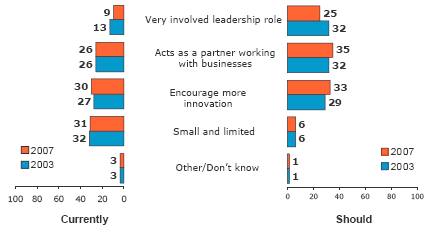
Base: Total respondents (n=1200)
2007 TNS Canadian Facts
Subgroup differences
- Perceptions of the Government's current and preferred roles differ substantially by age. Younger Canadians (18 to 24) are much more likely to believe that the Government of Canada currently does (45% think the Government is either in a leadership 12% or partnership role 33%), and should act as a business partner (36%) or take a leadership role (31%). In contrast, among seniors (65 years and older), few think that it currently is in a leadership (7%) or business partner role (18%) even though they would prefer these roles (24% and 28% respectively).
- Lower income households (less than $25,000) are slightly more likely than high income households ($75,000 or more) to think the government is taking a leadership role (10% versus 7%, not statistically significant) but they are much more likely to prefer that role (32% versus 20%). That said, higher income households are somewhat more likely to say that the government already acts more as a partner (31% compared with 23% for the lower income households).
- Those with university education are much more likely to perceive that the government is already acting as a partner (33%) compared to those with less education (20% for those with high school or less). That said, those with less education would prefer a more active role for government (30% of those with high school or less education would prefer a leadership role).
- When it comes to the preferred role there are no statistically significant differences by region. There are, however, some differences when it comes to the perceived current role. Most notably, Quebec residents are more likely to see the government as playing a limited role (36%) vs. 26% in Atlantic Canada, 32% in Ontario, 29% in the Prairies, and 27% in B.C.
3b. Importance of Responsible Investment of Public Funds
Canadians place importance on several measures the Government of Canada can put in place to ensure responsible investment when it does play a leadership role in the economy by investing public funds. Measures consistently deemed to be important include those assuring accountability (ensuring clear reporting of investments and anticipated results, 91%) and those involving political considerations (safeguards against political influence, 90%; and regional equality, 86%).
Although still considered to be important by a strong majority, slightly fewer award importance to basing investment decisions on recommendations from independent experts (80%), ensuring investments are repayable (78%) and ensuring other groups like local government and businesses support the initiative by cost sharing (78%).
Figure 3-b
Responsible Investment
Q: Turning now to investments in the Canadian economy and businesses, when the Government of Canada invests public funds in the economy, what level of importance would you place on each of the following to ensure responsible investment?
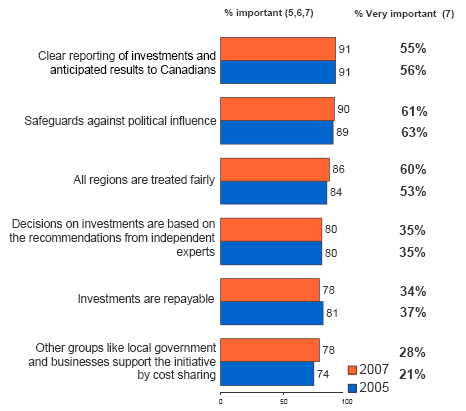
Base: Total respondents (n=1200)
2007 TNS Canadian Facts
Sub-group Differences
Clear reporting
- Clear reporting is more important for older Canadians. For example, 62% of those who are 50 to 64 years of age think it is very important to have clear reporting (7 on 7-point scale) compared with 49% of 18-24 year olds who feel it is that important.
Safeguards against political influence
- Similarly it is older Canadians who feel safeguards against political influence are important. Ninety-four per cent of those 50 to 64 years and 89% of those 65 years and older think it is important compared with 86% in the 18 to 24 year old age group.
- Quebecers are less likely to believe that it is of utmost importance to ensure safeguards against political influence (87% overall and 61% very important (7 on 7-point scale). B.C. residents (94% overall and 70% very important) are more likely to perceive this measure is important (the other provinces are more similar to Quebec on this measure).
Regional Equality
- Atlantic Canada residents are the most concerned that all regions are treated fairly when investments are meted out (94% vs. scores in the 80% range in the rest of Canada).
Role of Experts
- Younger Canadians (18 to 24) place less emphasis on the role of experts (67% compared with 77% of those aged 25 to 34; 83% for those aged 35 to 49; 84% of those aged 50 to 64 and 81% of those over 65).
Local Support
- Education and income are the main drivers of how much importance is placed on local support. For example, 84% of those with high school education or less think it is important compared with 72% of those who are university educated.
Repayment
- Young people are less likely to place importance on repayment. For example, of those 18 to 24, 74% think repayment is important (28% think it is very important) compared with 82% of seniors (42% think it is very important).
- Those with high school education or less are more likely to think that it is important that it the investments are repayable as compared with those with university education (83% and 75% respectively).
3c. Support for Government Assistance to Business
The desire for more government involvement is in keeping with the desire to have government provide business assistance. As in past iterations of the study, the notion of repayment does not increase support for assistance.3
3 Half the sample was asked the question with the word repayable and the other half was asked the question without signaling out that the assistance is repayable.
Interestingly, there is almost equal support for the government providing assistance to businesses with a proven track record (86%), where there is presumably less risk, as there is for businesses with trouble accessing capital (83%), where risk would likely be higher. Although the overall support for these two propositions is similar, there are more people who feel strongly about funding those with a proven record (43%) than those that cannot access capital (33%).
One in five Canadians (20%) is of the view that government assistance to business is always wrong and compared to 2003 there has been a marginal shift away from the position that government assistance is always wrong (from 23% in 2003 to 20% in 2007). Notably, 77 per cent are opposed to this view (38% strongly).
Figure 3-c
Support for Government Assistance to Business
Q: Please tell me whether you strongly agree, somewhat agree, somewhat disagree or strongly disagree with the following statements. How about …?
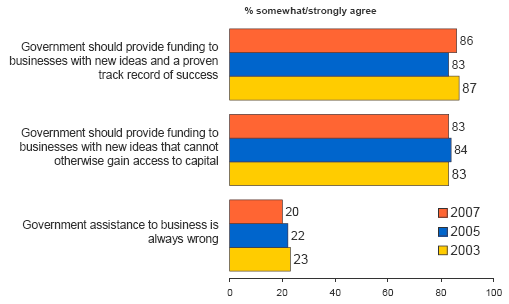
Base: Total respondents (n=600)
2007 TNS Canadian Facts
While the view that government should provide funding is universally held, by region and demographics there are a number of small but highly significant differences.
- Regionally, support for government investment is somewhat lower in the West and higher in the East. Only 13% of Atlantic residents think Government of Canada funding is always wrong compared to 31% in the Prairies.
- The view that funding is always wrong increases with age. Of those who are of retirement age, 26% think that funding is always wrong and 21% are opposed to funding for businesses that cannot otherwise gain access to capital.
- Men are somewhat more likely than women to feel that funding should be provided to businesses that cannot otherwise gain access to capital (87% versus 80%). Women (17%), on the other hand, are less likely than men (23%) to feel that government funding for businesses is always wrong.
- Higher education and income are both associated with higher support for government assistance. Eighty-four per cent of those with university education reject the idea that government funding is always wrong compared with only 69% of those with high school education or less.
3d. Repayment of Government Assistance
The introduction of the word "repayable" as a condition for the receipt of government assistance does not fundamentally change public views about the appropriateness of different forms of government assistance. Counter-intuitively, more people are opposed to repayable assistance (28%) than to a more generic government assistance with no mention of repayment (20%).
Consistent with their views on government assistance to businesses in general, 88 per cent of Canadians believe that the Government should provide repayable funding to those with a proven track record. The notion of repayment has a marginal, not statistically significant, impact on support (from 86% to 88%).
Although Canadians opinions are essentially the same as two years ago, a longer view reveals a slight trend toward repayable funding for businesses with new ideas that cannot gain access to capital. Again, the fact that the assistance is repayable does not increase support for it appreciably (from 83% in 2003 to 87% in 2007).
Figure 3-d
Support for Repayable Government Assistance to Business
Q: Please tell me whether you strongly agree, somewhat agree, somewhat disagree or strongly disagree with the following statements. How about …?
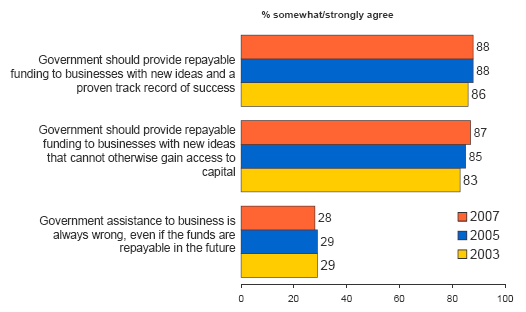
Base: Total respondents (n=600)
2007 TNS Canadian Facts
Sub-group Differences
There are a number of significant sub-group differences in support for repayable government assistance but the pattern is largely the same as it is for government assistance without the repayment condition.
- Regional differences are quite modest.
- Consistent with their views on Government funding in general, Atlantic residents (96%) are more likely to believe that the Government should be providing repayable funding to businesses with a proven track record compared to citizens in other regions of the country (Quebec, 88%; Ontario, 85%; the Prairies, 91%; B.C., 89%).
- Quebec residents are much more likely to be opposed to the premise of repayable government support for business than they were to the concept in general (34% vs. 23%).
- In contrast to the situation noted for funding in general, where there were differences of opinion between men and women, when the condition of repayment is introduced these differences essentially disappear.
3e. Importance of Various Industries to Canada's Economic Health
The success of various Canadian industries is generally perceived of as highly important to the strength of the Canadian economy in the future. Specifically, the Environmental Technologies industry (95%) and the Natural Resources sector (95%) are perceived as the most valuable, with two-thirds of Canadians judging each to be very important for ensuring future economic health (68% and 66% respectively).
The Information Communications Technology (ICT) or Telecommunications industry (89%) and the Biotechnology industry (86%) are also perceived as valuable whereas fewer think that the Automotive (67%) and Aerospace (69%) industries are important.
Figure 3-e
Importance of Industries to Future Economy
Q: Please tell me how important you feel each of the following industries are to ensuring that Canada's economy is healthy in the future. For each, please tell me if you feel it is very important that Canada succeeds in this sector, important, not all that important, or not important at all. How about …?
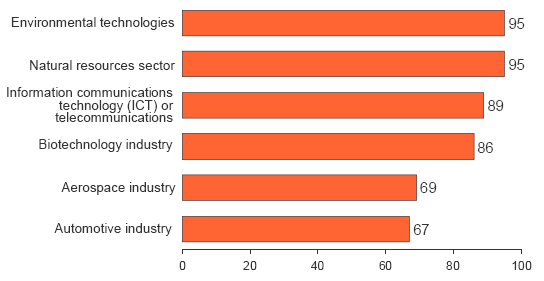
Based on net very important/important
Base: Total respondents (n=1200)
2007 TNS Canadian Facts
Sub-group Differences
Some regional and demographic differences provide indications as to why the automotive and aerospace sectors are not judged to be as important as other industries tested:
- The automotive industry is perceived to be less important to Quebec residents (57%) than it is to residents of other regions, particularly in Atlantic Canada (74%) and Ontario (73%).
- Interestingly, Quebecers are no more likely than residents of other regions to feel the aerospace industry is important to ensuring that Canada is healthy in the future.
- Women are less likely than men to believe that the aerospace industry is important (65% versus 73%, respectively).
- Young Canadians (aged 18-24) are considerably less likely to believe that mature industries including automotive, aerospace and ICT/Telecommunications, are important compared to older Canadians.
- When it comes to the automotive industry, 59% of those 18 to 24 think it is important. The industry is considered more important by older age groups: 64% of those 25 to 34, 68% of those 35 to 49, 71% of those 50 to 64 and 73% of those 65 and older.
- The differences are modest for the biotechnology sector; 86% of those 18 to 24: 83% of those 25 to 34, 90% of those 35 to 49, 88% of those 50 to 64 and 80% of those 65 and older believe it is important that Canada succeeds in this sector.
4. Research and Development
This section examines the perceived value of research and development (R&D) in advancing sustained economic growth, and in general, the quality of life of Canadians, while also assessing the Government of Canada's role in regulating and investing in R&D.
4a. Innovation Versus R&D
The terms innovation and R&D appear to be largely synonymous for the public. In a split-sample design, where half the sample was asked the extent to which they agreed with attributes relating to innovation and the other with the same attributes relating to R&D, findings reveal there are virtually no differences in responses obtained. There is a tendency for the public to see the benefits of both more in terms of economic growth than quality of life.
Canadians overwhelmingly agree that both R&D and innovation are important to sustained economic growth (98%) and a higher quality of life (94%). In this case, the proportion of respondents who report they 'strongly agree' is worthy of mention: 67 per cent feel strongly that innovation and 70 per cent that R&D are important to achieve sustained growth. The perceived impact on quality of life is somewhat lower. Sixty-five per cent feel strongly that R&D and 58 per cent that innovation will improve the lives of Canadians.
Figure 4-a
Innovation and R&D
Q: Please tell me whether you strongly agree, somewhat agree, somewhat disagree or strongly disagree with the following statements. How about …?
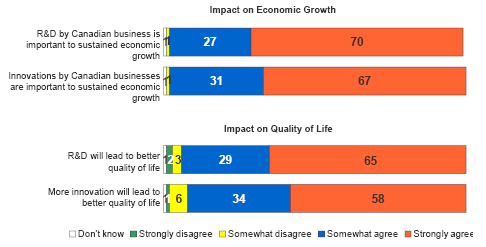
Base: Half of respondents (n=600/600)
2007 TNS Canadian Facts
Subgroup Differences
- Higher income and higher education groups are more likely to make the differentiation between R&D and innovation and in so doing tend to associate economic benefits with R&D rather than with innovation. They are also more likely to identify economic vs. quality of life benefits to R&D. The view that R&D and innovation are key to sustained economic growth rises with household income and education.
- While 59% of those earning less than $25k feel strongly that R&D is important, this proportion is 82% among upper income ($75k+) households.
- Similarly, those with university education are more likely to feel strongly about the economic impacts of R&D (73%) than those with lower levels (59% for those with high school or less).
- Quebec residents are less likely than residents of other provinces to strongly believe that R&D (63% vs. 79% in Atlantic, 70% in Ontario, 68% on the Prairies, and 79% in B.C.) and innovation (55% vs. 73% in Atlantic, 70% in Ontario and the Prairies, and 74% in B.C.) are important to sustained economic growth.
- This same regional relationship holds when one considers the impact on quality of life. Almost half of Quebec residents (49%) feel strongly that R&D is important to quality of life compared with 63% in Atlantic Canada, 62% in Ontario, 57% on the Prairies, and 60% in B.C.
4b. Leadership in a Knowledge-Based Economy
Three-quarters of Canadians (74%) are concerned with Canada's ability to be a leader in the knowledge-based economy, down from levels of 81 per cent in 2003 and 2005. Canadians are also less likely in 2007 than in 2005 or 2003 to express strong concern about Canada's leadership ability (30%, versus 43% and 35%, respectively).
Figure 4-b
Canada's Ability to be a Leader
Q: Please tell me whether you strongly agree, somewhat agree, somewhat disagree or strongly disagree with the following statements. How about 'I am concerned about Canada's ability to be a leader in the knowledge-based economy'?
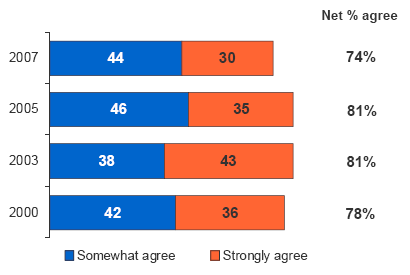
Base: Total respondents (n=1200)
2007 TNS Canadian Facts
Sub-group Differences
There are a few notable differences by age and region, while income and education differences are unimportant.
- Quebec residents (64%) are less likely than those in other regions (Atlantic, 84%; Ontario, 77%; Prairies, 77%; B.C., 78%) to be concerned about Canada's ability to be a leader in the knowledge-based economy. Furthermore, Quebecers are least likely to express strong concern with this statement (19% vs. 43% in Atlantic, 35% in Ontario; 29% on the Prairies; 34% in B.C.).
- The proportion of Canadians who are strongly concerned with Canada's leadership ability in the knowledge-based economy rises with age. Seniors more than twice as likely as Canadians aged 18 to 24 to express strong concern with the statement (38% vs. 16%).
4c. Technological Advances
A strong majority of Canadians (89%) believes that it is important that Canada be more technologically advanced than other countries, with fully half (50%) holding strong views on this matter. Given that in 2007 the statement was changed from "as technologically advanced" to "more technologically advanced", a direct comparison to previous years is not possible.
Since the overall agreement to the two statements is similar however, one can conclude that both questions are tapping the importance of technological advancement. In the 2005 statement, the implication of strong agreement is related to not falling behind whereas in 2007 it is clearly pointing to the need to be ahead of others. The notion of surpassing others may not be core to the Canadian mindset.
Figure 4-c
Canada Must Remain More Technologically Advanced
Q: Please tell me whether you strongly agree, somewhat agree, somewhat disagree or strongly disagree with the following statements. How about '…'?

*Note: There was a slight wording change in this year's study.
Base: Total respondents (n=1200)2007 TNS Canadian Facts
Sub-group Differences
There are a number of noteworthy regional and demographic differences.
- Men (60%) feel much more strongly than women (41%) that Canada needs to be more technologically advanced than other countries.
- The importance of being more advanced rises with increasing age. Seniors (65+) are twice as likely to be strongly concerned compared to young Canadians (18-24) (60% versus 30%, respectively).
- Concern also rises with increasing household income. Those in the upper income group ($75k+) are more likely to be strongly concerned than those in the lowest income group (
4d. Importance of Innovation
Most citizens (97%) feel it is important that Canadian businesses be innovative and continue to develop new products, services and ideas, with nearly three-quarters (73%) holding strong views on this issue. Compared to 2003, there has been a slight weakening in the public's views on the importance of innovation.
Figure 4-d
The Importance of Innovation in Canadian Businesses
Q: Please tell me whether you strongly agree, somewhat agree, somewhat disagree or strongly disagree with the following statements. How about 'It is important that Canadian businesses are innovative, and continue to develop new products, services, and ideas'?
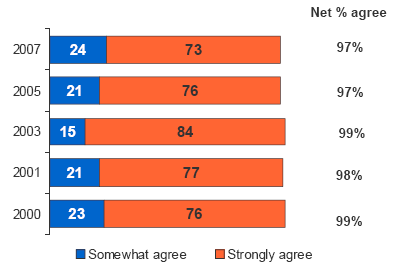
Base: Total respondents (n=1200)
2007 TNS Canadian Facts
There are a few demographic differences to note.
- Men (78%) feel more strongly than women (68%) that business innovation is important.
- Young Canadians (18-24) (56%) are far less likely than those aged 25 and older to strongly believe that innovation is important to Canadian businesses.
- Lastly, there is a strong relationship between income and opinion on this matter and others relating to research and development. The importance awarded to business innovation also rises with increasing household income. Those in the upper income group ($75k+) are more likely to have strong views about the importance of innovation than those in the lowest income group (
4e. Using and Selling R&D Products
As in 2005, Canadians (92%) generally think that our businesses need to do a better job of using and selling the new ideas and products that come out of research and development in this country, and fully half (52%) hold strong views on this issue.
Figure 4-e
Businesses Must Sell Ideas and Products
Q: Please tell me whether you strongly agree, somewhat agree, somewhat disagree or strongly disagree with the following statements. How about 'Canadian businesses need to do a better job using and selling the new ideas and products that come out of research and development in this country?
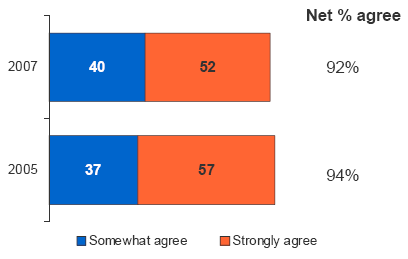
Base: Total respondents (n=1200)
2007 TNS Canadian Facts
Sub-group Differences
While the view that a better job is needed is universal, the strength of opinion differs by region and demographic groups.
- Residents of Atlantic Canada are more likely to strongly believe (64%) that our businesses need to do a better job of utilizing R&D output compared to residents of other regions (Quebec, 52%; Ontario, 52%; Prairies, 52%; and B.C., 48%).
- Men (57%) hold stronger views on the matter than women (48%).
- Younger Canadians (18-24), who of course have less history of engagement in the workforce, are less likely to hold strong views (37%) compared to those age 35 plus. For example, 55% of seniors (65 or older), 61% of those aged 50 to 64, and 53% of those aged 35 to 49 feel strongly that Canadian businesses need to do a better job commercializing their R&D activities.
4f. Perceived Advantages of Federal Government Investment
While Canadians consistently support the view that R&D has economic and quality of life benefits, they have difficulty expressing the benefits in the absence of prompts. In 2007, more than four in ten (43%) indicated that they were not sure what the economic advantages of R&D are for Canada up from 30 per cent in 2005. This suggests that there may be a high level of understanding of the benefits to the economy but an inability to be specific about the actual economic mechanisms that translate investments into economic benefits.
Some Canadians are, of course, able to identify specific benefits such as increased competitiveness (11%), reduced brain drain (9%), increased productivity (7%) and new product development (6%).
Figure 4-f
Canadian Economic Advantages (total mention)
Q: Thinking of federal government support for research and development, what economic advantages come to mind for Canada?
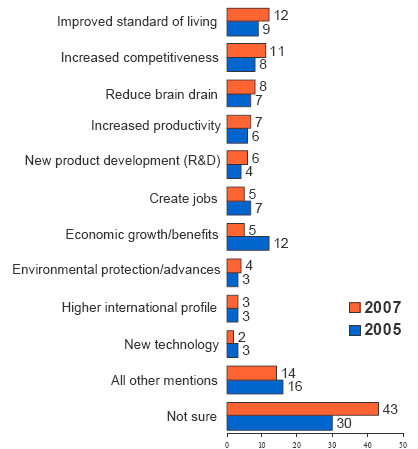
Base: Total respondents (n=1200)
2007 TNS Canadian Facts
5. Science and Technology
New to Industry Canada's General Population Survey in 2007, this section examines the perceived value of Government of Canada Science and Technology (S&T) initiatives.
Perceived Value of Government Initiatives to Support S&T
Canadians place a high value on initiatives that the Government of Canada could take or is already taking to support S&T activities in business and the educational sector.
Nearly all Canadians (93%) believe that the Government must encourage businesses to work with Canadian universities and colleges for the development of technology with half (56%) believing that this is of the highest value, i.e. scores of 7 on a 7-point scale. Similarly, most Canadians (91%) believe that supporting the development of S&T technology skills in businesses, colleges and universities is valuable, although marginally fewer judge this to be of the highest value (47%).
Figure 5
Government Supporting S&T
Q: There are a number of initiatives targeting Canadian businesses that the Government of Canada could take or is already taking to support businesses that undertake S&T activities. Please tell me how valuable you think the following would be to Canada.
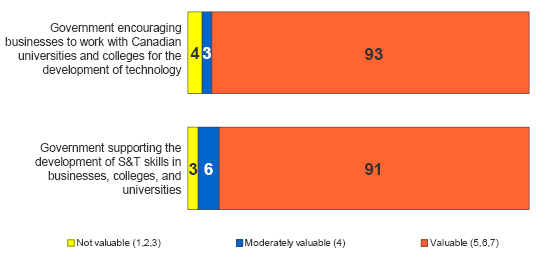
Base: Total respondents (n=1200)
DK= less than 0.5%
2007 TNS Canadian Facts
6. Telecommunications
This section examines Canadians' views on telecommunications services, and on the Government of Canada's role in particular in regulating and promoting the telecommunications industry.
6a. Satisfaction with Current Telecommunications Services in Canada
Canadians are generally more satisfied than not with their telecommunications services, and are particularly satisfied with the high degree of technology, product, and service innovation (80%), strong Canadian-owned telecommunications companies (77%) and a telecommunications system that helps keep our economy competitive (77%).
Canadians are less satisfied with the level of Canadian-based R&D in telecommunications (69%), and access to telecommunications services in rural areas (58%).
Figure 6-a
Telecommunication Services in Canada Today
Q: Please tell me whether you are very satisfied, satisfied, dissatisfied or very dissatisfied with the following aspects of telecommunications services in Canada today. How about …?
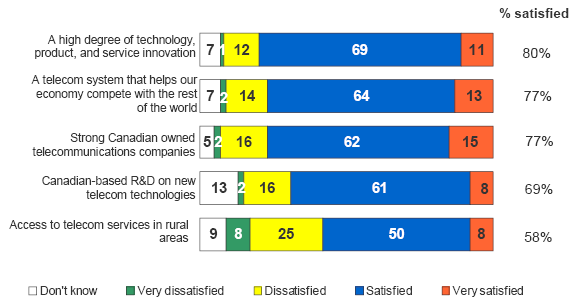
Base: Total respondents (n=1200)
2007 TNS Canadian Facts
Sub-group Differences
Regionally there are some key differences.
- Although they are not particularly satisfied with the level of Canadian R&D in telecommunications (57% vs. 79% in Atlantic, 71% in Ontario, 76% in the Prairies and 70% in B.C.), Quebec residents (83%) are more satisfied with the strength of Canadian-owned telecommunications companies than residents of other regions, particularly those in Atlantic Canada (72%) or Ontario (72%).
- Quebec residents (80%) are much more satisfied with access to telecommunications services in rural areas than are residents from other provinces, especially Atlantic Canada (49%) and B.C. (45%).
- Perhaps influenced by the growing number of call centres in the region, Atlantic residents, express the highest satisfaction (86%) for a telecommunications system that helps keep Canada competitive in the world.
The only other significant demographic differences pertain to age and community size.
- When it comes to rural access, not surprisingly, those in small communities and rural areas (under 30,000 population) express greater dissatisfaction (40% dissatisfied) than those living in larger centres. In comparison, only 26% of those living in the most urban centres (500,000 or more) are dissatisfied.
- Younger Canadians (18-24) (74%) are much more likely to be satisfied with access to telecommunications services in rural areas than older age groups, particularly those in the 50-64 age-group (49%). Younger citizens are also more satisfied with Canadian-based R&D such that 81% of those under 25 are satisfied compared with only 64% of those 65 or older.
6b. Preference Between Detailed and General Telecommunications Rules4
Canadians vastly prefer that the government provide general rules (62%) and rely on oversight and competition in the marketplace rather than have a detailed set of rules (35%) that spell out what services telecommunications companies can offer and the prices that they can charge. The preference for general rules has declined since 2005 when 79 per cent felt government should provide general rather than detailed rules.
Figure 6-b
Government Approaches to Telecommunication Goals
Q: The Government of Canada can choose different approaches to meet its goals. I will present two situations to you, each one involving two different approaches. Please tell me which approach you would prefer …

Base: Total respondents (n=1200)
DK= 3%
2007 TNS Canadian Facts
Sub-group Differences
- Among the general public, this preference is more pronounced among those with higher incomes. Seven out of ten (69%) in the upper income group ($75k+) favour only general rules, compared to just over half (55%) among the lowest income group (
4 Question previously asked in 2005 and reported in Bell Canada's submission to the Telecommunications Policy Review Panel as Appendix D-12, "Consumer Attitudes on Telecommunications Regulation". Used with permission from Decima Research.
6c. Preference Between Government Approval or not for New Telecommunications Services5
The majority of Canadians prefer that telecommunications services be offered to customers without prior government approval (59%) rather than having it approved and priced by the government before it can be offered to customers (38%).
Support for an unregulated approach to the introduction of new services is lower than in 2005. At that time, 71 per cent thought companies should be able to offer services without prior government approval.
Figure 6-c
Government Approaches to Telecommunication Goals
Q: The Government of Canada can choose different approaches to meet its goals. I will present two situations to you, each one involving two different approaches. Please tell me which approach you would prefer …
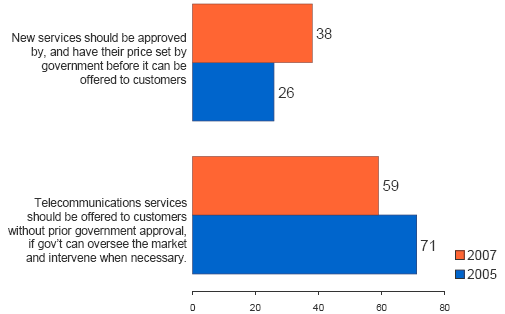
Base: Total respondents (n=1200)
DK= 2%
2007 TNS Canadian Facts
There are, however, notable differences in the willingness to have telecommunications services offered without prior government approval.
- Consistent with their views that government should provide only minimal rules, those in the upper income group ($75k+) also feel that new telecommunications products should be offered without government approval (71%).
- In contrast to their counterparts in other regions, Quebecers are far less comfortable with the concept of offering new telecommunications services without government approval. In fact, almost half (48%) feel that such new services should be approved and priced by the government versus 38% overall.
5 Question asked with permission from Decima Research.
6d. Preference Between Encouraging Foreign Investment in Canada's Telecommunications Sector or Maintaining Current Limits
Generally, Canadians would prefer that the Government maintain the current foreign investment and ownership limits in the telecommunications sector (69%) to ensure Canadian control rather than encourage foreign investment and ownership in Canada's telecommunications sector (29%) even if foreign competition yielded more innovation and new technologies. This is, perhaps, not surprising given that 80 per cent of Canadians are at least somewhat satisfied with the level of innovation in the sector. The support for the current system exists across the ideological spectrum. Even those who prefer a limited role for government in the economy are not more likely to want foreign ownership encouraged.
Figure 6-d
Government Approaches to Telecommunication Goals
Q: The Government of Canada can choose different approaches to meet its goals. I will present two situations to you, each one involving two different approaches. Please tell me which approach you would prefer …

Base: Total respondents (n=1200)
DK= 3%
2007 TNS Canadian Facts
While these views are universally held across all regions and demographic groups, there are a number of small but significant differences:
- Younger Canadians (18-34) are more receptive to the idea of foreign investment, than their older counterparts. For example, 39% of those in the 25-34 age group favour foreign investment versus only 21% among the 65+ group. Canadians aged 50+ (76%) are more likely than Canadians aged 18-49 (62%) to prefer that the Government of Canada maintain the current foreign investment and ownership limits in the telecommunications sector.
- Low (24% of those with household incomes less than $25,000) and middle (28% of those with $25,000 to $75,000) income earners are less likely than high income earners (33% of those with more than $75,000) to prefer that the Government encourage foreign investment and ownership in Canada's telecommunications sector.
7. Methodology
Telephone interviews were conducted with a random sample of Canadians 18 years and older with a total of 1,200 completed interviews. Interviewing took place between February 5 and March 1, 2007. The margin of error for a sample of this size is 2.9 (see below for margin of error for regions).
The survey was conducted using the FACTS Network, TNS Canadian Facts' CATI system. The sample is representative of all regions of Canada, and was drawn slightly disproportionately to allow for larger sample sizes in the smaller regions, i.e. Atlantic Canada and the Prairies. Individuals 18 years of age and older were interviewed in the household, using the "next birthday" selection technique.
TNS Canadian Facts' telephone interviewing is continuously monitored, with at least 10% of the interviewing either partially or fully monitored. Copies of the questionnaires appear in the Appendix to this report.
| Total | Atlantic | Quebec | Ontario | Prairies | B.C. | |
|---|---|---|---|---|---|---|
| Unweighted completions | (1200) # | (155) # | (271) # | (368) # | (262) # | (144) # |
| M.E. | 2.9 | 8.0 | 6.1 | 5.2 | 6.2 | 8.3 |
7a. Weighting
Weighting adjustments were applied to the final edited, clean data to ensure that the data are representative of the adult population of Canada. Following is the breakdown of actual and weighted completions by region.
| Total | Atlantic | Quebec | Ontario | Prairies | B.C. | |
|---|---|---|---|---|---|---|
| (1200) # | (155) # | (271) # | (368) # | (262) # | (144) # | |
| Males | 545 | 24 | 54 | 92 | 39 | 21 |
| Females | 655 | 41 | 102 | 142 | 78 | 57 |
| * Figures percentaged on a base of less than 100 should be interpreted with caution | ||||||
| Total | Atlantic | Quebec | Ontario | Prairies | B.C. | |
|---|---|---|---|---|---|---|
| (1200) # | (89) # | (288) # | (464) # | (197) # | (162) # | |
| Males | 589 | 30 | 80 | 114 | 56 | 38 |
| Females | 611 | 31 | 84 | 120 | 57 | 40 |
7b. Record of Call
| Total Numbers Attempted | 14153 | |
| Invalid Numbers / Sample: | 6012 | |
| 1. Not in service | 4598 | |
| 2. Non-residential | 1171 | |
| 3. Fax/modem | 224 | |
| 4. Other ineligible | 19 | |
| Unresolved In-Scope Sample: | 3280 | |
| 5. Busy | 206 | |
| 6. Answering Machine | 1371 | |
| 7. No answer | 1333 | |
| 8. Language | 179 | |
| 9. Household Refusal/Other | 191 | |
| Resolved but Non-Responding: | 3654 | |
| 10. Selected/eligible respondent not available | 316 | |
| 11. Appointment/Callback | 182 | |
| 12. Respondent Refusal/Other | 3156 | |
| Resolved and Responding | 1207 | |
| 13. Disqualified | 0 | |
| 14. Completed Interview | 1200 | |
| 15. No such person / deceased | 0 | |
| 16. Other terminations | 7 | |
| Response Rate | 15% |
8. Field Materials
Questionnaire
Hello, my name is ______________ and I am calling from TNS Canadian Facts, a public opinion research company. We are conducting a survey on behalf of Industry Canada, a department of the Government of Canada with regard to economic issues. Please let me assure you that we are not trying to sell anything — this is strictly a survey, which should take approximately 15 minutes to complete and your responses will remain completely confidential. This survey is registered with the national survey registration system.
May we speak to the person in your household who is over 18 years of age and who will be celebrating their birthday next?
Interviewer note: If anyone questions the validity of the survey, they can contact Line Patry (613-948-1549)
Use standard call outcomes
Q1: S, QT
The Government of Canada has identified a number of potential priorities it can pursue to support businesses and to encourage economic growth in Canada. For each of the following, please tell me how much emphasis you think should be placed on that particular area. Please use a 7-point scale, where '1' means the lowest priority, and '7' the highest priority. How about…?
Insert MT
AL
- 1 — Lowest Priority
- 2
- 3
- 4
- 5
- 6
- 7 — Highest Priority
- Don't Know
Randomize Q1 MT
Q1MT — Not all respondents should see all statements. Each respondent needs to have a 50% probability that a given statement will come up.
- Encouraging innovation and research and development among Canadian businesses
- Ensuring a fair marketplace for consumers and businesses
- Supporting the commercialization or market success of products and services that are researched or developed in Canada
- Encouraging regional economic development.
- Encouraging more investment in the economy and Canadian businesses
- Making government services for business readily accessible on the Internet
- Ensuring that all Canadian communities have high-speed access to the Internet.
- Promoting sustainable development — that is economic growth that does not harm the environment.
- Promoting inter-provincial trade
- Invest in growing sectors of the economy
- Help businesses that are in declining economic sectors adjust to the new economy
Q2: S, QT
How would you rate the performance of the Government of Canada in each of these same areas? Please use a similar 7-point scale, where '1' means a very poor job, and '7' a very good job. How about …?
Insert MT
AL
- 1 — Very Poor Job
- 2
- 3
- 4
- 5
- 6
- 7 — Very Good Job
- Don't Know
Randomize Q2 MT
Each respondent should see only the statements they saw in Q1
- Encouraging innovation and research and development among Canadian businesses
- Ensuring a fair marketplace for consumers and businesses
- Supporting the commercialization or market success of products and services that are researched or developed in Canada
- Encouraging regional economic development.
- Encouraging more investment in the economy and Canadian businesses
- Making government services for business readily accessible on the Internet
- Ensuring that all Canadian communities have high-speed access to the Internet.
- Promoting sustainable development — that is economic growth that does not harm the environment.
- Promoting inter-provincial trade
- Invest in growing sectors of the economy
- Help businesses that are in declining economic sectors adjust to the new economy
Q3: S, QT
In your view, which of the following statements comes closest to your own perception of the role that the federal government currently plays in the Canadian economy? Would you say that …
Read List
AL
- The Government takes a very involved leadership role in the economy.
- The Government acts more as a partner working with businesses.
- The Government's main role is to encourage more innovation in the economy.
- The Government plays a very small and limited role in the economy
- Some other role, specify
- No role
- Don't Know
Q4: S, QT
And now thinking about the same list, which of the following statements comes closest to your own perception of the role that the federal government should play in the Canadian economy? Would you say that …
Read List
AL
- The Government takes a very involved leadership role in the economy.
- The Government acts more as a partner working with businesses.
- The Government's main role is to encourage more innovation in the economy.
- The Government plays a very small and limited role in the economy
- Some other role, specify
- No role
- Don't Know
Q5: S, QT
Please tell me whether you strongly agree, somewhat agree, somewhat disagree or strongly disagree with the following statements. How about …?
Insert MT
AL
- Strongly agree
- Somewhat agree
- Somewhat disagree
- Strongly disagree
- Don't Know
Randomize MT
Half sample gets first option and half gets second option within each in A and B
- Innovations by Canadian businesses are important to sustained economic growth. Or
Research and development by Canadian business is important to sustained economic growth - More innovation will lead to better quality of life Or
Research and development in Canada will lead to better quality of lifeFull sample for remainder
- I am concerned about Canada's ability to be a leader in the knowledge-based economy.
- It is important that Canada be more technologically advanced than other countries
- It is important that Canadian businesses are innovative, and continue to develop new products, services and ideas.
- Canadian businesses need to do a better job of using and selling the new ideas and products that come out of research and development in this country.
Q6A: S, QT
Thinking of federal government support for research and development, what economic advantages come to mind for Canada?
Do not read list. Record first response.
AL
- Improved quality of life/standard of living of Canadians
- Reduce brain drain/keep jobs in Canada
- Increased productivity of Canadian businesses
- Increased competitiveness of Canadian firms
- General economic benefits (specify)
- Jobs — Unspecified
- None/Nothing
- Not Sure/Don't Know
- Other (specify)
- Don't Know
Q6B: S, QT
What other economic advantages come to mind?
Do not read list. Record second response. Mask response from Q6A unless other or general economic benefits.
AL
- Improved quality of life/standard of living of Canadians
- Reduce brain drain/keep jobs in Canada
- Increased productivity of Canadian businesses
- Increased competitiveness of Canadian firms
- General economic benefits (specify)
- None/Nothing
- Not Sure/Don't Know
- Other (specify)
- Don't Know
Q6C: S, QT
What other economic advantages come to mind?
Do not read list. Record third response. Mask response from Q6A and Q6B unless other or general economic benefits.
AL
- Improved quality of life/standard of living of Canadians
- Reduce brain drain/keep jobs in Canada
- Increased productivity of Canadian businesses
- Increased competitiveness of Canadian firms
- General economic benefits (specify)
- None/Nothing
- Not Sure/Don't Know
- Other (specify)
- Don't Know
Q7: S, QT
Turning now to investments in the Canadian economy and businesses, when the Government of Canada invests public funds in the economy, what level of importance would you place on each of the following to ensure responsible investment? Please use a 7-point scale, where 1 is not important at all, and 7 is very important. How about …?
Insert MT
AL
- 1 — Not important at all
- 2
- 3
- 4
- 5
- 6
- 7 — Very important
Rotate Q7 MT
- Ensure that decisions on investments are based on recommendations from independent experts
- Ensure that there would be clear reporting of investments and anticipated results to Canadians
- Ensure that there would be safeguards against political influence on where investments would go
- Ensure all regions are treated fairly in terms of how investments are spread out
- Ensure that other groups like local government and businesses support the initiative by sharing some of the costs
- Ensure that the investments are repayable
Q8: S, QT
Please tell me whether you strongly agree, somewhat agree, somewhat disagree or strongly disagree with the following statements. How about …?
Insert MT
AL
- Strongly agree
- Somewhat agree
- Somewhat disagree
- Strongly disagree
- Don't Know
Randomize MT
Half sample sees
- Government assistance to business is always wrong, even if the funds are repayable in the future.
- Government should provide repayable funding to businesses with new ideas that cannot otherwise gain access to capital.
- Government should provide repayable funding to businesses with new ideas and a proven track record of success.
Half sample sees
- Government assistance to business is always wrong.
- Government should provide funding to businesses with new ideas that cannot otherwise gain access to capital.
- Government should provide funding to businesses with new ideas and a proven track record of success.
I'd like to turn to issues related to science and technology, often referred to as S&T.
Q9: S, QT
There are a number of initiatives targeting Canadian businesses that the Government of Canada could take or is already taking to support businesses that undertake S&T activities. Please tell me how valuable you think the following would be to Canada. To do this, use a 7-point scale, where '1' means not valuable at all, and '7' means very valuable. How about …?
Insert MT
AL
- 1 — Not valuable at all
- 2
- 3
- 4
- 5
- 6
- 7 — Very valuable
Half sample sees:
Government encouraging businesses to work with Canadian universities and colleges for the development of technology.
Other half sees:
Government supporting the development of science and technology skills in businesses, colleges and universities.
Q10: S, QT
Please tell me how important you feel each of the following industries are to ensuring that Canada's economy is healthy in the future. For each, please tell me if you feel it is very important that Canada succeeds in this sector, important, not all that important, or not important at all. How about …?
Insert MT
Rotate MT
AL
- Very Important
- Important
- Not all that important
- Not important at all
- Don't Know/Refused
- The Automotive industry
- The Aerospace industry
- The Information Communications Technology (ICT) or Telecommunications industry
- The Biotechnology industry
- The Natural Resources sector
- The Environmental Technologies industry
Q11: S, QT
Turning now to telecommunications, please tell me whether you are very satisfied, satisfied, dissatisfied or very dissatisfied with the following aspects of telecommunications services in Canada today. How about …?
Insert MT
AL
- Very satisfied
- Satisfied
- Dissatisfied
- Very dissatisfied
- Don't Know/Refused
Rotate MT
- A high degree of technology, product and service innovation.
- Strong Canadian owned telecommunications companies.
- Access in rural areas to the telecom services that people need.
- Canadian-based research and development on new telecom technologies.
- A telecommunications system that helps our economy compete with the rest of the world.
Programmer: Rotate selections for Q12 and Q13 and Q14
Q12 QT should appear first, then QT for Q13
Q12: S, QT
The Government of Canada can choose different approaches to meet its goals. I will present two situations to you, each one involving two different approaches. Please tell me which approach you would prefer:
AL
- Government should have detailed rules that spell out what services telecommunications companies can and can't offer and the prices they can charge
- Government should provide general rules and rely on oversight and competition in the marketplace to produce the best mix of services and pricing.
- Don't Know/Refused
Q13: S, QT
What about for the following two situations …?
Read list
AL
- Whenever a company wants to introduce a new telecommunications service into the marketplace it should be approved by, and have its price set by, government before it can be offered to customers
- Telecommunications services should be offered to customers without prior government approval, as long as government has the ability to oversee the market and intervene to make changes when necessary.
- Don't Know/Refused
Q14: S, QT
What about for the following two situations …
Read list
AL
- Government should encourage foreign investment and ownership in Canada's telecommunications sector to stimulate more competition, more innovation and the introduction of new technologies
- Government should maintain the current foreign investment and ownership limits in the telecommunications sector to ensure that Canada retains control of this sector and that major corporate decisions about telecommunications continue to be made in Canada
- Don't Know/Refused
I have a few last questions for statistical purposes. Please remember that your responses to these and other questions will be kept confidential.
Q15: Q, QT
Range 1900 .. 1990 Def 1990,
In what year were you born [Record year]
Q16: S, QT
What is the highest level of formal education that you have completed? Please stop me when I reach your category
[Read list]
AL
- Grade 8 or less
- Some high school
- Complete high school
- Technical, vocational post-secondary
- Some university
- Complete university degree
- Post graduate degree
- Refused
Q17: S, QT
For statistical purposes only, what is the total household income before taxes, that is, the total income of all members in this household? Would it be $50,000 or more, or would it be less than $50,000 per year?
AL
- $50,000 or over
- Under $50,000
- Don't know
- Refused
Ask Q18 if over $50000
Ask Q19 if under $50000
Q18: S, QT
Would it be …?
Read list
AL
- $50,000 to $74,999
- $75,000 to $99,999
- More than $100,000
- Don't Know
- Refused
Q19: S, QT
Would it be …?
AL
- $25,000 to $49,999
- Less than $25,000
- Don't Know
- Refused
Q20: S, QT
Do you have access to the Internet?
AL
- Yes
- No
- Don't Know/Refused
Q21: Q, QT
Range 0 .. 1 Def 1,
What are the first three digits of your postal code?
That is all my questions. Thank you very much for taking the time to complete this survey.

